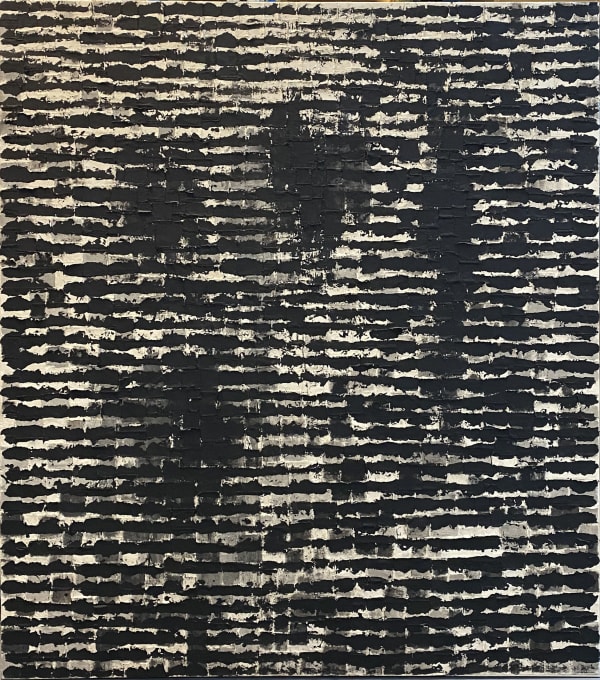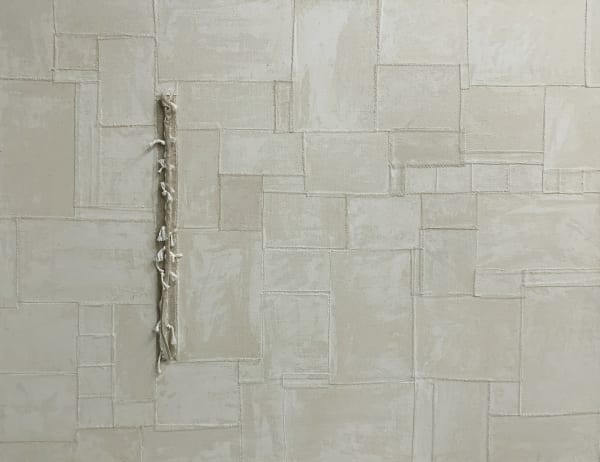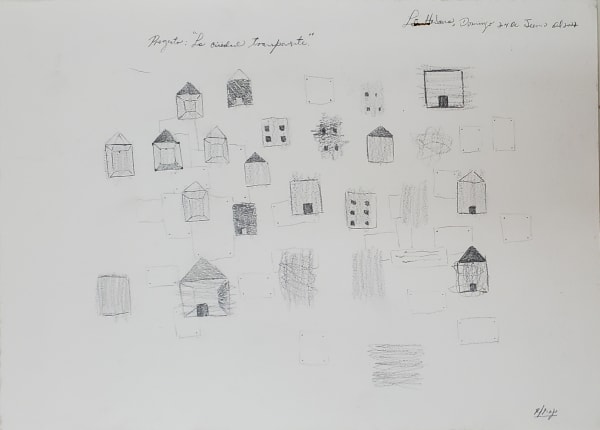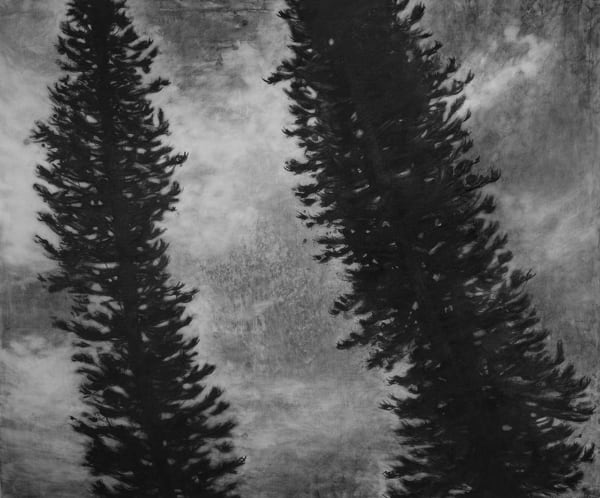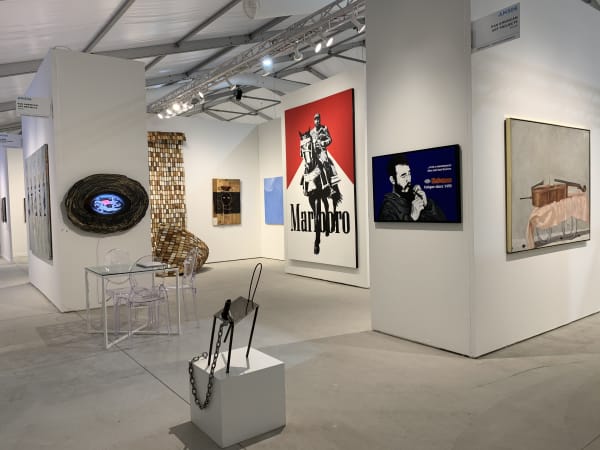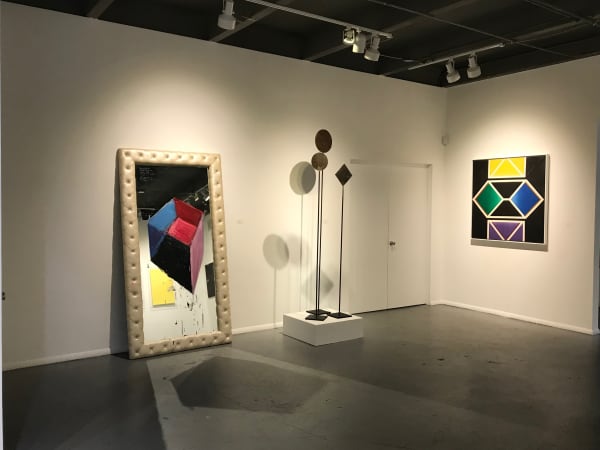Juan Roberto Diago was born in 1971 in Havana, Cuba, and has been part of the Cuban art scene since the early nineties. He graduated from the San Alejandro Academy, in Havana, in 1990, and began to exhibit soon after.
Diago comes from a family of artists, and the work of his grandfather, after whom he is named, was a big influence. The senior Roberto Diago was one of the pivotal voices of Cuban Art in the Forties, despite his short life.
-
 J. Roberto DiagoLa Ciudad Transparente (set of 8 houses), ca.2009Mixed mediaDimensions variableSoldView more details
J. Roberto DiagoLa Ciudad Transparente (set of 8 houses), ca.2009Mixed mediaDimensions variableSoldView more details -
 J. Roberto DiagoLa Ciudad Transparente (set of 8 houses), ca. 2000Mixed media9 x 6 x 6 in (2 small houses)$ 2,800.00
J. Roberto DiagoLa Ciudad Transparente (set of 8 houses), ca. 2000Mixed media9 x 6 x 6 in (2 small houses)$ 2,800.00
14 x 9 x 9 in (6 large houses)View more details -
 J. Roberto DiagoLa Ciudad Transparente, set of 4, ca. 2000Mixed media8 x 8 x 8 in each piece (4 pieces)SoldView more details
J. Roberto DiagoLa Ciudad Transparente, set of 4, ca. 2000Mixed media8 x 8 x 8 in each piece (4 pieces)SoldView more details -
 J. Roberto DiagoUntitled, from the series Lagrimas Negras, ca. 1996Oil and collage on canvas58.50 x 80.50 in
J. Roberto DiagoUntitled, from the series Lagrimas Negras, ca. 1996Oil and collage on canvas58.50 x 80.50 in
148.59 x 204.47 cmView more details -
 J. Roberto DiagoMagic Carpet, 2019Painted wood tiles connected with metal clips360 x 30 x 1 in
J. Roberto DiagoMagic Carpet, 2019Painted wood tiles connected with metal clips360 x 30 x 1 in
914.4 x 76.2 x 2.5 cmView more details -
 J. Roberto DiagoUntitled, 2017Mixed media on canvas59 x 47 inSold
J. Roberto DiagoUntitled, 2017Mixed media on canvas59 x 47 inSold
149.9 x 119.4 cmView more details -

-
 J. Roberto DiagoUntitled, 2014Mixed media on canvas
J. Roberto DiagoUntitled, 2014Mixed media on canvas
(Small strips of canvas painted individually and collaged on canvas)120 x 79 in
304.8 x 200.66 cmView more details -
 J. Roberto DiagoDe La Serie: 'La Paz de Tu Alma', 2013Mixed media on canvas59 x 79 inSold
J. Roberto DiagoDe La Serie: 'La Paz de Tu Alma', 2013Mixed media on canvas59 x 79 inSold
149.86 x 200.66 cmView more details -
 J. Roberto DiagoUntitled, 2013Mixed media on wood47.25 x 31.50 inSold
J. Roberto DiagoUntitled, 2013Mixed media on wood47.25 x 31.50 inSold
120.01 x 80.01 cmView more details -

-
 J. Roberto DiagoUntitled, 2012Mixed media on canvas39.50 x 51.50 inSold
J. Roberto DiagoUntitled, 2012Mixed media on canvas39.50 x 51.50 inSold
100.33 x 130.81 cmView more details -
 J. Roberto DiagoUntitled, 2012Mixed media on canvas67 x 59 inSold
J. Roberto DiagoUntitled, 2012Mixed media on canvas67 x 59 inSold
170.18 x 149.86 cmView more details -
 J. Roberto DiagoUntitled, 2012Oil on canvas collaged on canvas39.50 x 51.50 inSold
J. Roberto DiagoUntitled, 2012Oil on canvas collaged on canvas39.50 x 51.50 inSold
100.33 x 130.81 cmView more details -
 J. Roberto DiagoYo Naci Libre, 2009Acrylic on Wood47 x 31.50 inSold
J. Roberto DiagoYo Naci Libre, 2009Acrylic on Wood47 x 31.50 inSold
119.38 x 80.01 cmView more details -
 J. Roberto DiagoProyecto: La Ciudad Transparente, 2007Pencil on heavy paper10 x 13.50 inSold
J. Roberto DiagoProyecto: La Ciudad Transparente, 2007Pencil on heavy paper10 x 13.50 inSold
25.4 x 34.29 cmView more details -

-
 J. Roberto DiagoEl Poder de la Presencia, 2006Installation of a group of wood houses built with wood walls collected from houses in the artist’s neighborhood Pogolotti, Havana; metal roofs; a couple contain videos of life in the neighborhood.Dimensions variableSoldView more details
J. Roberto DiagoEl Poder de la Presencia, 2006Installation of a group of wood houses built with wood walls collected from houses in the artist’s neighborhood Pogolotti, Havana; metal roofs; a couple contain videos of life in the neighborhood.Dimensions variableSoldView more details -
 J. Roberto DiagoMi Señora, 2005Mixed media photo light box33 1/4 x 29 1/4 x 6 1/2 in
J. Roberto DiagoMi Señora, 2005Mixed media photo light box33 1/4 x 29 1/4 x 6 1/2 in
84.5 x 74.3 x 16.5 cmView more details -
 J. Roberto DiagoHoy No Es Mi Dia De Morir, 2004Mixed media on metal39 1/2 x 39 1/2 x 3 in
J. Roberto DiagoHoy No Es Mi Dia De Morir, 2004Mixed media on metal39 1/2 x 39 1/2 x 3 in
100.3 x 100.3 x 7.6 cmView more details -
 J. Roberto DiagoLa Sangre esta en la Tierra, 2004mm on canvas20 x 16 in
J. Roberto DiagoLa Sangre esta en la Tierra, 2004mm on canvas20 x 16 in
50.8 x 40.64 cmView more details -
 J. Roberto DiagoFrom "Aquí lo que no hay es que morirse" series, 2003Mixed media on metal78 1/2 x 59 1/2 x 8 in
J. Roberto DiagoFrom "Aquí lo que no hay es que morirse" series, 2003Mixed media on metal78 1/2 x 59 1/2 x 8 in
199.4 x 151.1 x 20.3 cmView more details -
 J. Roberto DiagoUntitled from the series "Rostros que solo yo veo", 2003Photo collage. Unique60 x 40 in
J. Roberto DiagoUntitled from the series "Rostros que solo yo veo", 2003Photo collage. Unique60 x 40 in
152.4 x 101.6 cmView more details -
 J. Roberto DiagoUntitled, from series "Rostros que solo yo veo", 2003Photo collage. Unique60 x 40 in$ 5,000.00
J. Roberto DiagoUntitled, from series "Rostros que solo yo veo", 2003Photo collage. Unique60 x 40 in$ 5,000.00
152.4 x 101.6 cm
UniqueView more details -
 J. Roberto DiagoUntitled, Series "Rostro que solo yo Veo", 2003Photo collage60 x 40 in
J. Roberto DiagoUntitled, Series "Rostro que solo yo Veo", 2003Photo collage60 x 40 in
152.4 x 101.6 cmView more details -
 J. Roberto DiagoLa Vida Me Gusta Mucho, 2000Car paint and pencil on heavy paper27.50 x 19.70 in
J. Roberto DiagoLa Vida Me Gusta Mucho, 2000Car paint and pencil on heavy paper27.50 x 19.70 in
69.85 x 50.04 cmView more details -
 J. Roberto DiagoEl, from the series Lagrimas Negras, 1996Oil on canvas79 x 95 1/2 in
J. Roberto DiagoEl, from the series Lagrimas Negras, 1996Oil on canvas79 x 95 1/2 in
200.7 x 242.6 cmView more details -
 J. Roberto DiagoLa Ciudad Transparente #1mixed media3 houses measuring 5 x 5 eachSoldView more details
J. Roberto DiagoLa Ciudad Transparente #1mixed media3 houses measuring 5 x 5 eachSoldView more details -
 J. Roberto DiagoLa Ciudad Transparente set of 2 small housesMixed mediaHouses measuring 5 x 5 eachSoldView more details
J. Roberto DiagoLa Ciudad Transparente set of 2 small housesMixed mediaHouses measuring 5 x 5 eachSoldView more details
During his career Diago has participated in numerous exhibitions in and outside of Cuba. One of the milestones was when in 1997 he represented Cuba in the prestigious Venice Biennale in Italy. His works can be found in prestigious collections around the world, such as the National Museum of Fine Arts in Havana, Cuba; the CIFO (Cisneros Fontanals Art Foundation) in Miami, Florida; and the Rubin Foundation Collection, New York.
From the very beginning Diago has been occupied with identity, which he rendered through themes of social inferences. Thematically the unifying thread in his oeuvre has been his critique to racism in Cuba; something that ‘officially’ doesn’t exist but is present in daily life in the country. His older pieces were distinguished by the use of materials such as discarded wood and metal, as a reference to the living conditions of black people in the country. Although these conditions are not exclusively for black people, they are the ones who historically lived in the poorest neighborhoods, thus often bearing the worst situations. This was the inspiration behind many of Diago’s well-known installations, in which he was compelled to represent scaled down houses made to look like the real ones.
-

¿Y esa luz? Es tu sombra - A Symphony of Lights and Shadows
Selection of works from R. Borlenghi’s Collection Marzo 29 - Mayo 25, 2024Pan American Art Projects is please d to announce ¿Y esa luz? Es tu sombra - A Symphony of Lights and Shadows , a collective exhibition from R. Borlenghi’s Collection....Leer más -

The Universal Language of Abstraction
Collective Show Enero 20 - Marzo 19, 2019The Universal Language of Abstraction is an exhibition that aims to explore the abstract trends in Contemporary Art through the works of artists with diverse origins, backgrounds, and techniques. The...Leer más








